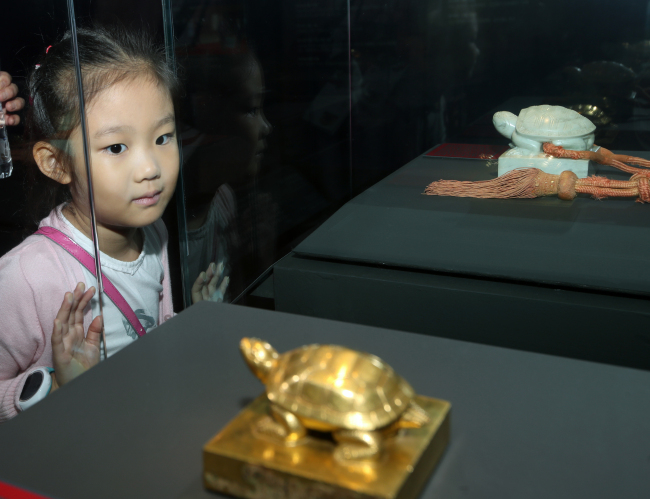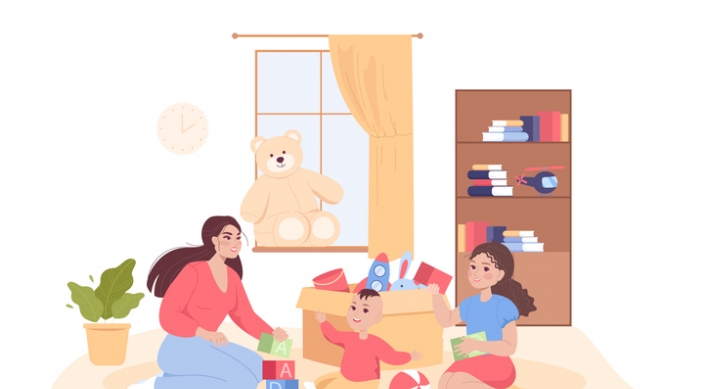‘Fake royal seal’ controversy mars special exhibition
By Yoon Min-sikPublished : Aug. 24, 2017 - 17:48
What was supposed to have been a ceremonious occasion marking the return of long-lost Joseon-era royal seals has turned into a dogfight between the state-run Cultural Heritage Administration and civic groups over the legitimacy of one of the artifacts.
Last week, the CHA held a press conference heralding an exhibition of royal artifacts from the Korea’s Joseon era (1392 to 1910). The Golden Royal Seal for the Bestowal of Honorific Title upon Queen Munjeong and Royal Seal of King Hyeonjong are among 12 repatriated royal seals that are being exhibited at the National Palace Museum of Korea from Aug. 18 to Oct. 29.

The two royal seals were repatriated via the presidential plane, arriving in Korea alongside President Moon Jae-in after his first summit with US President Donald Trump in July.
But controversy surrounds the Golden Royal Seal for the Bestowal of Posthumous Title upon King Deokjong, which was originally created in 1471 before being reproduced in 1924 after having been long-lost, and was repatriated to Korea in 2015.
Royal seals were used to honor the virtue of kings and queens of Joseon. Deokjong, who died before ever ascending to the throne, was posthumously honored as a king by his son King Seongjong and a seal was made.
The Deokjong seal on display at the museum is the one made in 1924, well after the country had been annexed by Japan in 1910. At the time, royal household affairs were managed by the Office of the Yi Dynasty, a department of the Japanese administration governing the peninsula that did not answer to the king. It was this office that had the seal remade.
“We did not realize that (the seal had been made during the Japanese colonial period) when the seal was repatriated. Subsequent analysis revealed that it was not created during the Joseon era,” said National Palace Museum of Korea director Kim Yeon-soo at a press conference introducing the royal seals last week. “It was re-created in 1924 upon the order of Sunjong (last monarch of the Korean Empire) and was approved by the royal family.”
But Jongmyo Ilji -- the official record of royal rites and memorials in Jongmyo -- had no record of the king ordering it to be stored at Jongmyo.
Rather, it showed that the seal was stored by Lee Hang-gu -- an official of the Office of the Yi Dynasty and the son of pro-Japanese politician Ye Wan-yong – suggesting that it was made at his direction, and not the king’s.
Director Kim admitted the error in a phone call with local media.
“What is certain is that the royal seal was created under orders of the Joseon royal family and it holds sufficient value as a historical relic. It just happens to have been created during an unfortunate period for the Korean people,” said an official from CHA, maintaining the agency’s position that the Deokjong seal has the same value as the original made in the 15th century.
Civic groups are demanding that the seal be excluded from the exhibition, saying it cannot be placed alongside legitimate royal seals.
Buddhist monk the Ven. Hyemoon -- the head of Restoring Cultural Properties in Their Rightful Place, which campaigned to bring back Queen Munjeong’s seal to Korea -- asked whether an artifact created under Japanese rule can be regarded as an actual Joseon-era seal.
“The seal is a fake one made by a supporter of Japan and holds a very different value compared to other authentic seals. The only reason they want to display it is to boast their accomplishment,” he said.
He also pointed out that while royal seals typically have 60 percent of its composition in gold, the Deokjong seal had less than 30 percent.
Hyemoon’s group has petitioned the National Palace Museum of Korea to pull King Deokjong’s seal from the exhibition, to which the state-run museum has not responded.
If the museum continues to snub the request, he said he will take the case to the Board of Audit and Inspections of Korea.
“Hopefully, it won’t come to that,” he said.
Kim could not be reached for questions and museum officials refused any comment, saying it has relayed the matter to CHA.
By Yoon Min-sik
(minsikyoon@heraldcorp.com)








![[Today’s K-pop] BTS pop-up event to come to Seoul](http://res.heraldm.com/phpwas/restmb_idxmake.php?idx=644&simg=/content/image/2024/04/17/20240417050734_0.jpg&u=)
![[Graphic News] More Koreans say they plan long-distance trips this year](http://res.heraldm.com/phpwas/restmb_idxmake.php?idx=644&simg=/content/image/2024/04/17/20240417050828_0.gif&u=)







![[KH Explains] Hyundai's full hybrid edge to pay off amid slow transition to pure EVs](http://res.heraldm.com/phpwas/restmb_idxmake.php?idx=652&simg=/content/image/2024/04/18/20240418050645_0.jpg&u=20240419100350)

